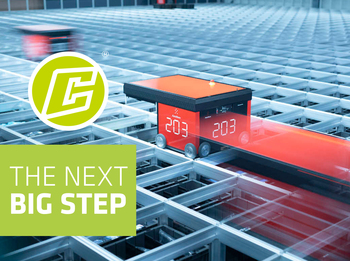
Our next big step: AUTOSTORE
 Only 10 months after moving into our new headquarters, our two Managing Directors are initiating another big step. In just five weeks' time, the warehousing system at our premises in Mannheim will be moving into the future.
Only 10 months after moving into our new headquarters, our two Managing Directors are initiating another big step. In just five weeks' time, the warehousing system at our premises in Mannheim will be moving into the future.Now that we have settled into our new headquarters, quickly filling up the 3,950 m2 of warehousing space, which initially seemed unbelievably large, it's already time for the next new and ground-breaking step. A highly advanced, innovative system for automatic warehousing will soon be arriving: AutoStore
AutoStore could be defined as the ultimate in space efficiency, as it offers the best storage density ratio of all the container warehousing systems currently available. With AutoStore we can achieve four times the level of storage capacity in comparison to manual storage, using the same floor space. As almost any grid form is possible, this means maximum utilisation of the building. For example, we can build around the building supports and can also make optimal use of any areas of flooring with an irregular layout. With the compact and automatic storage and order picking of small components in plastic containers, we will in future be able to do without aisles and shelves. The containers are placed on top of one another, allowing us to save around 75% of the storage space previously used. Above the piles of containers there is a system of guiding rails (grid) along which high speed robots travel. They tirelessly take containers (bins), sort them and deliver them to the ports for incoming goods and order picking which are connected directly to the system.
The robot lowers its grabbing plate into the pile, picks up a bin with its grabbers, and lifts it up to the upper surface of the grid. The grabbing plate can be lowered down as far as the base of each pile. If the robot needs a bin on Level 9, it firstly removes eight bins and places them on other piles in the immediate surrounding area, using free space as a temporary space holder. When it has finished moving around the containers in the pile, another robot tidies up and puts the bins back in the same order as before. After a bin has been presented at the port, it is once again placed at the top of a pile of bins. If the bin is often required, it will therefore remain at the top. If the bin is only selected occasionally, it will automatically move down to the bottom of the grid and bins that are more in demand will be placed on top of it.
As well as the unbelievably high level of space efficiency achieved, the robots save a lot of energy as a system with ten robots consumes only around the same amount of energy as a vacuum cleaner. As soon as the robot lowers a bin or reduces its speed, electricity is generated through regenerative energy functions and fed into the batteries again. A further plus point is that the robots do not require any light, meaning that they can work in conditions with poor lighting or even in the dark.
|
|
|





